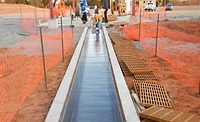Axalta Has the World’s Second Largest Radio Telescope Covered

This spring Axalta Coating Systems, one of the leading global suppliers of liquid and powder coatings, has once again produced a special coating for the radio telescope in Effelsberg, Germany, one of the largest, fully-steerable radio telescopes in the world, and the most powerful for short-wave radiation. The Effelsberg telescope is used to observe pulsars, cold gas and dust clusters, star formations, jets of matter emitted by black holes, and the nuclei of far-off galaxies. It is also used as part of a worldwide network of radio telescopes for astronomic observations at the highest resolutions.
Axalta helps to protect the telescope from weathering and UV radiation with a matte-white polyvinylic coating called PercoTop CS551 Foliflex Topcoat. This specially-formulated, tailor-made coating has been applied to the telescope approximately every 18 years since it began operating in 1972.
Painting the telescope takes a minimum of six specially trained painters several weeks. “With a surface of 5400m and with 1500 individual panels, the portion of the dish that needs to be coated is immense,” says Klaus Bruns from the Max Planck Institute for Radio Astronomy, who is responsible for the technical maintenance of the Effelsberg telescope.
“It is important that we can keep the delicate aluminum substrate of the reflectors at an even surface temperature to obtain accurate measurements with the telescope. Having a coating that protects the aluminum from deformation, weathering, bird droppings and UV radiation is therefore absolutely essential.”
Dr. Harald Paulussen, Technical Product Manager and Application Engineering, Industrial and Transportation Coatings for Axalta in Europe, Middle East and Africa, says, “The original coatings’ tests during the construction phase of the telescope took place in 1968. A considerable number of tests were required to develop the optimal formulation for the telescope. It became clear that in addition to weather-resistance, it was necessary for the coating not to interfere at all with the electro-magnetic waves, to be almost invisible to them. This ‘transparency’ helps to ensure that the incoming radio waves are reflected off the metal surface of the telescope and not off the paint. It was also important to achieve a scattered reflection of infra-red radiation as the reflectors’ large areas can generate significant heat. Once we knew exactly what was needed for the end-application, we developed a formulation that would address all these requirements.”
The coating is applied with rollers, with no primer, after sanding the surface of the telescope using large disc sanders with a diameter of around 20cm. The large sanders, which resemble vacuum cleaners, allow the painters to sand and collect the dust generated simultaneously.
The work will be completed in summer 2015, and the Effelsberg radio telescope will continue delivering accurate measurements while being protected with Axalta’s PercoTop CS551 Foliflex Topcoat.
Looking for a reprint of this article?
From high-res PDFs to custom plaques, order your copy today!






